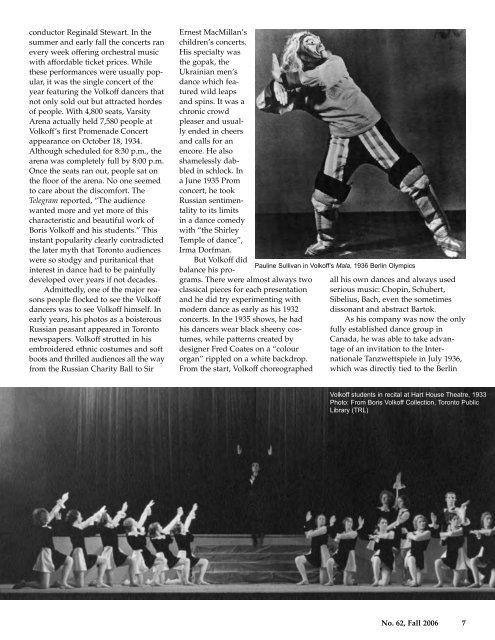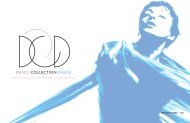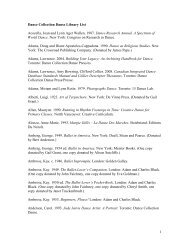Jeanne Renaud - Dance Collection Danse
Jeanne Renaud - Dance Collection Danse
Jeanne Renaud - Dance Collection Danse
Create successful ePaper yourself
Turn your PDF publications into a flip-book with our unique Google optimized e-Paper software.
conductor Reginald Stewart. In the<br />
summer and early fall the concerts ran<br />
every week offering orchestral music<br />
with affordable ticket prices. While<br />
these performances were usually popular,<br />
it was the single concert of the<br />
year featuring the Volkoff dancers that<br />
not only sold out but attracted hordes<br />
of people. With 4,800 seats, Varsity<br />
Arena actually held 7,580 people at<br />
Volkoff’s first Promenade Concert<br />
appearance on October 18, 1934.<br />
Although scheduled for 8:30 p.m., the<br />
arena was completely full by 8:00 p.m.<br />
Once the seats ran out, people sat on<br />
the floor of the arena. No one seemed<br />
to care about the discomfort. The<br />
Telegram reported, “The audience<br />
wanted more and yet more of this<br />
characteristic and beautiful work of<br />
Boris Volkoff and his students.” This<br />
instant popularity clearly contradicted<br />
the later myth that Toronto audiences<br />
were so stodgy and puritanical that<br />
interest in dance had to be painfully<br />
developed over years if not decades.<br />
Admittedly, one of the major reasons<br />
people flocked to see the Volkoff<br />
dancers was to see Volkoff himself. In<br />
early years, his photos as a boisterous<br />
Russian peasant appeared in Toronto<br />
newspapers. Volkoff strutted in his<br />
embroidered ethnic costumes and soft<br />
boots and thrilled audiences all the way<br />
from the Russian Charity Ball to Sir<br />
Ernest MacMillan’s<br />
children’s concerts.<br />
His specialty was<br />
the gopak, the<br />
Ukrainian men’s<br />
dance which featured<br />
wild leaps<br />
and spins. It was a<br />
chronic crowd<br />
pleaser and usually<br />
ended in cheers<br />
and calls for an<br />
encore. He also<br />
shamelessly dabbled<br />
in schlock. In<br />
a June 1935 Prom<br />
concert, he took<br />
Russian sentimentality<br />
to its limits<br />
in a dance comedy<br />
with “the Shirley<br />
Temple of dance”,<br />
Irma Dorfman.<br />
But Volkoff did<br />
balance his programs.<br />
There were almost always two<br />
classical pieces for each presentation<br />
and he did try experimenting with<br />
modern dance as early as his 1932<br />
concerts. In the 1935 shows, he had<br />
his dancers wear black sheeny costumes,<br />
while patterns created by<br />
designer Fred Coates on a “colour<br />
organ” rippled on a white backdrop.<br />
From the start, Volkoff choreographed<br />
Pauline Sullivan in Volkoff’s Mala, 1936 Berlin Olympics<br />
all his own dances and always used<br />
serious music: Chopin, Schubert,<br />
Sibelius, Bach, even the sometimes<br />
dissonant and abstract Bartok.<br />
As his company was now the only<br />
fully established dance group in<br />
Canada, he was able to take advantage<br />
of an invitation to the Internationale<br />
Tanzwettspiele in July 1936,<br />
which was directly tied to the Berlin<br />
Volkoff students in recital at Hart House Theatre, 1933<br />
Photo: From Boris Volkoff <strong>Collection</strong>, Toronto Public<br />
Library (TRL)<br />
No. 62, Fall 2006 7





